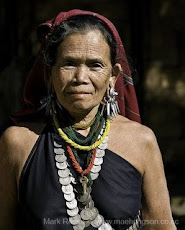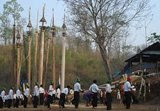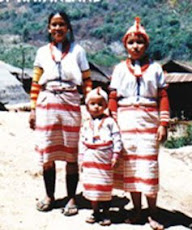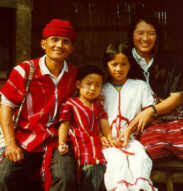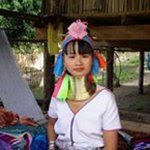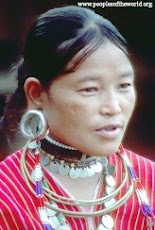Karenni is a religious and ethnically diverse territory. The following groups are mentioned in the 1983 census: Kayah, Geko (Gaykho), Geba (Gaybar), Padaung/Kayan, Bres, Manu-Manaus (Manumanao), Yintale, Yinbaw, Bwe, Paku (Karen), Shan and Pao. Other ethnic, though non-native groups living in the state are: Kachin, Chin, Burmese, Mon, Rakhine, Chinese, Indian, Pakistani, Bangladeshi and Nepalese. The main ethnic tribes can be classified under the heading ?Karen?. It is believed that the Karen migrated from Mongolia in about B.C. 2015, moving south towards Karenni where they finally settled in the Demawso area around
739 BC. From 739 BC until the 17th century AD communities within Karenni States were ruled over by elected leaders. In the 18th century, troops from one of the feudal states in Yun intruded into Karenni State, but the Karenni people united to repel these invaders. In the 18th century Poe Bya Da was elected as chief of the whole Karenni. Buok Poe Du (Pah Paw Gyi) established Sao Lon City on the east of the Pon River and ruled East Karenni. At that time, Karenni was divided into five sub-states, namely Eastern Karenni Kantarawadi, and Western Karenni, made up of Kyebogyi, Bawlake, Nanmakhon, and Naung Pale. Each state was ruled by its own chief after Poe Bya Da passed away. In 1809, the Eastern Karenni Chief Buok Poe Du (Pah Paw Gyi) signed a permanent Friendship Agreement with the Kingdom of Chiang Mai. In 1810 the ruler of the Burmese district of Yamethin attacked Karenni and occupied Mobye and Sakoi. In 1820, a Burmese ruler assigned Kan Hlaing to administer the occupied areas of Mobye and Sakoi. In 1823, Karenni troops regained control of Mobye and Sakoi. The population of Mobye banished Kan Hlaing. In 1826 Karenni chief Kay Poe Du (from Kyeh Poe Gyi) sent an emissary to Moulmein, the chief town of British Burma, in order to establish a diplomatic relationship with the British. In 1835, the Burmese king's troops attacked Karenni, but Karenni forces expelled them. In 1835, the British government sent an emissary to Karenni to demand that the Karenni chief allow their trade mission to pass through Karenni territory in order to trade with China. In 1837 a British official, Dr. Richardson, came to Karenni and met with Pah Paw Gyi between 2-4 Februarysohe could gain access to the China border. On 5 February 1837 Karenni troops led by Pah Paw Gyi marched and attacked Burmese troops, which were stationed at Mobye.
In 1845, the Burmese ruler of Inn Wa appointed Khun Sa to command the Burmese troops and attack Karenni forces in Mobye and Sakoi. The Burmese troops retreated and Khun Sa himself was captured by Karenni troops at Htee Taw Ku near Moso. Karenni forces killed and buried Khun Sa in Htee Paw Ku Lake. In 1885, the British government sent an emissary to Karenni chief Kay Poe Du in order to demarcate the boundary between Karenni and Toungoo (east of the Sittaung River), which had recently been occupied by the British. In 1857, British government representative Mr. O' Riley visited Karenni chief Kay Poe Du to set up an official relationship between the Karenni and the British. In the same year, the British representative Lord Dalhousie recognized Karenni independence. In 1862, Sawpja Kay Poe Du sent an emissary to the British government in Moulmein. In 1863 a signed Contract of Friendship was drawn up in Kyenphogyi between Mr E O�Rilay, Deputy British Commissioner of Toungoo, and Khun/Kwi Tee and Khun/Kwi Thyah sons of Sawphya Khaipodu of Western Karenni In 1868, Karenni chief Sawpja Khaipodu passed away. His two sons, Khwi Tee and Khwi Thjar, jointly succeeded him. In 1869, Sawpja Khwi Tee and Khwi Thjar sent another emissary to Moulmein to renew the alliance agreement with the British government. In March 1875, the viceroy of British-India sent a mission to the Burmese King Mindon in Mandalay to effect a settlement of the Karenni question and obtains the recognition of the independence and sovereignty of Karenni State. Behind this request was a desire to prevent the Burmese gaining access to Karenni�s rich teak forests. On 21st of June 1875, an agreement was signed between the Burmese and the British recognising the independence of the four western Karenni states: �It is hereby agreed between the British and Burmese Government that the State of Western Karenee shall remain separate and independent, and that no sovereignty or governing authority of any description shall be claimed or exercised over that State.� The agreement was signed by the two missions, with His Excellency the Kinwoon Mingyi, Minister for Foreign Affairs, signing on the part of His Majesty King Mindon of Burma; and the Honorable Sir Douglas Forsyth, C.B., K.C.S.I., Envoy, signing on the part of His Excellency the Viceroy and Governor General of India.
As part of the agreement, after the signing a British officer, A.H. Hildebrand, demarcated the boundary between Western Karenni and Burmese territory in 1976. Subsequently the Burmese troops stationed on the Karenni border area were withdrawn in 1877. Therefore, Karenni nationalists define their National Day as June 21.
In 1880, a British official reached the Karenni border on his tour of southern Shan State and invited East Karenni chief Sawpja Sao Lapaw to have a meeting with him. However, Sawpja Sao Lapaw declined the invitation. As a result British troops seized Mauk Mai district and appointed their subordinated chief Sawbwa Khun Mon to administer Mauk Mai.
In March 1888, Eastern Karenni chief Sawpja Sao Lapaw's troops re-captured Mauk Mai and expelled Khun Mon. On May 2nd 1888, the British official Colonel James George Scott and Lt. Fawlah came to Mauk Mai with 150 troops. On May 16 1888, the British mission re-instated Khun Mon as Sawbwa and returned to Moe Nai on July 1st. On July 3, 1888, Eastern Karenni troops attacked Mauk Mai again. On July 13, 1888, Eastern Karenni chief Sawpja Sao Lapaw wrote a letter to the British commander asking him to withdraw his troops from Mauk Mai. At the end of July 1888, British officials submitted the Mauk Mai problem to the British government in India. In August 1888, due to several attacks on Mauk Mai, the British government demanded that the Eastern Karenni chief agree to the following points: -Loyalty to the British Crown -To pay 200,000 rupees as war indemnity -To handover 500 swords -To pay an annual fee of 5,000 rupees Mr. Hildebrand sent this letter to Sawpja Sao Lapaw on November 16, 1888. However Sao Lapaw refused to comply with the demands. On December 9, 1888 British troops led by Colonel Harvey marched from Papon to attack Karenni from the south. However, on hearing the news the Karenni chief sent his troops to attack British troops at Kyauk Nyat, and burned down their camp before the British troops reached Karenni. On December 29, 1888, the British General H. Colette C.B and Mr Hildebrand led 500 British troops from Sakar to Loikaw in order to occupy the Eastern Karenni capital of Saw Lon. On January 1st, 1889, a battle took place at Nahn Kyai near Loikaw between Karenni and British troops. Over 150 of Sao Lapaw's men and four British troops were killed and a further eight men wounded in the gunfight.
On January 8, 1889, British troops captured Saw Lon. Sao Lapaw escaped to Manmu east of his capital near the Salween River, and 8 months later he died of diarrhea. Sao Lapaw's cousin Wei Reh (Sao Lawei) surrendered to British troops on January 20, 1889. On January 29, 1889, the British government appointed 38 year old Sao Lawei as Mayor (Myoza) of Saw Lon.
In January 1892 the four Western Chiefs, who had hitherto been nominally independent, were formally recognized as feudatories by the Government of India, and at a meeting held at Bawlake on the 23th January of that year, they were each presented with sanads appointing them Myozas. On January 24, 1892, the British government celebrated the Darbar festival in Loikaw and enacted the Sanad Act in Eastern Karenni.
Evidence indicating Karenni�s historical independence:
(1) In 1826 there was an exchange of diplomatic emissaries between the Karenni and the British governments. (2) In 1835 the British government asked permission from a Karenni chief to pass through Karenni territory to trade with China. (3) In 1855 the British government sent diplomats to Karenni on the matter of boundary demarcation between Karenni and British Burma. (4) There was an official relationship between the Karenni and the British. In 1857, the British representative Mr. O' Riley came to Karenni and signed an alliance agreement with Karenni chief Kay Poe Du. In the same year, the British representative Lord Dalhousie recognized Karenni�s independence. (5) In 1863 Mr. O' Riley came to Karenni and signed a Contract of Friendship between Britain and the sons of the chief of Western Karenni. (6) On June 21, 1875 representatives of the Viceroy of India andthe Burmese king signed an agreement recognizing Karenni�s independence in the presence of Karenni chief Sawpja Khwi Tee. (7) On 29th of January 1889 the British administration officer superintendent Heldy Brand assigned Sao Lawei as Mayor (Myoza) of Eastern Karenni and reviewed the rules on the assignment paper, which applied to Eastern Karenni. (8) On October 19, 1892, the Foreign Affairs Department of the British-India Government issued Notification No. 1920-E, which, together with Notification 83-1165-Int of the Foreign and Political Department dated January 16, 1923, state that Karenni does not form a part of British India, and is not subject to the laws in force in the Shan States or other parts of Upper or Lower Burma, therefore a British subject could not be prosecuted in Karenni state. (10) 1935 Government of India Act provides for Burma to be a separate country from India. 1936: Legislative Council elections, led to formation of Burmese government led by Ba Maw, under Government of Burma Act of 1935. 1 April 1937: Formal separation of Burma from India. The new Burmese administration had 91 departments. The Karenni States remained independent and were not subject to that administration.
Note: As the British government monopolized Karenni's economic sector, they applied the Sanad Act to Eastern Karenni on January 24, 1892. The Sanads contained 12 conditions, imposing the payment of tribute and conditions to protect the economic interests of the British, such as keeping open trade routes, keeping law and order, trade restrictions and bans on communicating with states outside British India. These were all one sided conditions of benefit only to the British. PART TWO: WORLD WAR II (Japanese occupation era)
In 1942 after the Japanese took control of Burma, Shan and Karenni, the Japanese Field Marshall Shozokawabi and the Burmese puppet government Prime Minister Dr. Ba Maw signed an agreement, written in both Japanese and Burmese regarding the relationship between Burma, Shan and Karenni. In order to expel Japanese troops from Karenni, the Kandarawaddy chief Sao Wonna, Kyeh Poe Gyi chief Saw Shwe, Bawlake chief Gobi Turee and Mobye chief Thaik Ba Han recruited about 2,000 men and cooperated with British Allied Forces Battalion No. 136. By the end of August 1945 the battles were ended. The Kayan National leader, Thaing Ba Han, was awarded the Order of the British Empire (OBE) by the British Allies because of his principles and military support. The Karenni troops were also awarded a shield by Battalion 136 to thank them for their help in beating the Japanese. On the shield the inscription read: �We honour a nation who we did not colonize and we'll remember them from sunset until sun rise�. PART THREE: BETWEEN 1945 AND 1948
On September 1, 1945, the British government sent Major Graham, then Karenni and Gilbert Grasu to Loikaw to be C.A.O in Karenni. At that time, political and administrative powers were in the hands of the 5 Karenni Sawphyas, who formed Council of Sawphyas to discuss and agree on matters concerning all the Karenni states. After the Second World War, due to the gradual change in the political climate, Karenni people chose new leaders from each state to lead the Karenni administration: Saw Shwe from Kyeh Poe Gyi, Sao Lawei and Sao Wonna from Kantarawaddi, U Bi Turee from North Bawlake and Thaik Ba Han from Mobye.
In February 1946, Shan Sawbwas invited Karenni chiefs to participate in the Panlong Conference to discuss the future of the Frontier States. However, because of Karenni's stance of independence, no Karenni representative attended the conference. In the same year, the Secretary of the Frontier Areas Administrative Board, Mr. H Stevenson, arrived at Loikaw and met with Karenni leaders, Gobi Turee from Bawlake, Saw Shwe from Kyeh Poe Gyi, Thaik Ba Han from Mobye, and Sao Shwe Hon and Saw Thein from Kantarawaddy to discuss the future of Karenni State after Burma became independent. On February 25, 1946 the Karenni National Organization and the Cooperative Association were formed. Gobi Turee was elected as President of the KNO and U Sein elected as Chairman of the Cooperative Association.
In March 1946 Thakin Nu, U Pe Khin and Mahn Ba Khaing, leaders of Anti-Fascist and People Freedom League (AFPFL) from Burma, came to Loikaw to lobby Karenni people to accept incorporation with future Burma. However, no Karenni leader attended the meeting.
On March 31, 1946, Mr Leech, the Commissioner of Taungyi, Shan States, invited Karenni leaders to a meeting with the Shan Sawbwas and Kachin Duwahs to discuss Karenni joining with them in the Frontier Areas Administrative Board. Sawpja Sao Lawei, Sao Zeina and people's representative U Ba Thaung from Kantarawaddy, Sawpja Saw Shwe and people's representative A Mya Lay from Kyeh Poe Gyi, Sawpja Sao Ngae Du and people's representative Lwizi from Bawlake, and Thaik Ba Han from Mobye attended the meeting. At the meeting, Karenni chiefs refused to join the FAAB, because of Karenni's independent status.
On April 3, 1946, a conference was held. It was agreed to form a Karenni-Padaung Council consisting of 16 members: one chief's representative and three people's representatives from each state must be included. The main tasks assigned to the council were to draft laws and regulations for the whole of Karenni State. On April 24, 1946, a Karenni delegation left for Rangoon to study the British-Burma Canvass for Votes program as observers, to study the political situation in British � Burma and to seek channels of communication. Sao Zeina, Sao Lawei, U Sein, U Ba Thaung, Saw Thein, and Ko Nyein from Kantarawaddy, Saw Shwe, A Mya Lay, and Maung Poe from Kyeh Poe Gyi, Gobi Turee, and Lwizi from Bawlake, and Thaik Ba Han and Saw Bikawah from Mobye were in the delegation. The delegation first visited Taungoo on April 26 and met with Saw John D. Poemin, the Karen MP. They were invited to observe the Karen National Organization meeting. The delegation then went on to Rangoon and met with Burmese General Aung San on April 30. Saw Shwe and Saw Thein met with Frontier Areas Administrative Board Secretary Mr. Stevenson at the Secretariat office. Mr. Stevenson told them that it was not necessary for the British to receive the Karenni delegation at this time, because the Burmese had already welcomed them as their guests.
On September 11, 1946, United Karenni Independent States Council was formed as the governing body and elected Gobi Turee as chairman, declaring Bawlake, Kyepogyi and Katarawaddy as Free states. On December 23, 1946, General Aung San, president of the AFPLF, visited Loikaw and delivered a political speech to induce the Karenni people to accept the accession of the Karenni States into the proposed Union of Burma. This was one of various attempts to seduce the Karenni. At the same time the British were lobbying the Karenni to join the Frontier Areas. In the beginning of 1947, Karenni people celebrated the Karenni New Year in Loikaw and hoisted the three stars Karenni flag at Loikaw football stadium.
No Karenni representative attended the Panlong Conference, which was held on February 12, 1947. This was because they feared it would compromise their independent sovereign status to attend. In April 1947 a meeting was held at which Karenni leaders decided not to accept the accession of Karenni States into Burma. A resolution was adapted to safe guard the independence and sovereignty of the Karenni States. On 14th April 1947 a Karenni and Mobye delegation met the inquiry commission of D.R. Rees William, MP, in Maymyo, Northern Shan States, after which they presented a petition containing 10 statements declaring the will of the the Karenni people. Gobi Turee and Shwe Lay from Bawlake, Thaik Ba Han and Paulu from Mobye, Saw Shwe and A Mya Lay from Kyeh Poe Gyi, Sao Lawei, U Sein, Ba Thaung, and J. Grasu from Kantarawaddy were in the mission. However, the British delegation dismissed the demands. On June 9, 1947, the Legislature (Constituent Assembly) was held in Rangoon, but no Karenni representative attended the meeting. However at the meeting the Karenni States were included as part of Burma in the new constitution. There was one concession: the 1947 Constitution granted the Kachin, Karenni and Shan a certain amount of autonomy in their own ethnic states and the right to cession from the Union of Burma after ten years. This pledge has never been honoured. On realizing the inclusion of Karenni into Burma, Mobye representative Thaik Ba Han, who was at the meeting, immediately rushed back to Karenni and informed the Karenni leaders of this news, while Karenni leaders were holding a meeting at Moso. On June 20, 1947, Karenni representatives Gobi Turee and Saw Thein met with the British governor-general in Rangoon. On June 26 Gobi Turee and Saw Thein issued a statement with regard to whether to incorporate with Burma or not upon their returning from Rangoon. On hearing the news about the new constitution, the Karenni leaders called an emergency meeting and assigned U Sein, Sao Wonna, A Mya Lay and Thaik Than Tin to go Rangoon to protest against the inclusion of Karenni in the Union of Burma's new constitution. This delegation went down to Rangoon in September 1947. However, instead of protesting about the new constitution, they were lured by AFPFL leaders to accept bribes and cooperate with them. Without the consent of the Karenni government and people, the delegation accepted the bribes and agreed to cooperate with Burma. They only objected to Chapter 9, Part 4, Article 180(1) (a), which said the Karenni, must be a special region in the planned new Karen State. Hearing this, Karenni leaders issued a statement dissolving the delegation immediately. In November 1947, the Burmese AFPFL leaders sent their military police into Karenni and equipped the traitors and their followers with arms. Karenni leaders wrote a letter to U Nu, leader of the AFPLF, protesting against military police being sent into Karenni without the permission of Karenni government and people. Karenni people and students gathered in Loikaw and demonstrated, showing their objection to the Burmese military presence. The 4 collaborators then set up a rival government. In November 1947 Karenni National Organization was formed in order to support the United Karenni Independence States Council (UKISC) politically.
The Karenni States is the name formerly given to the three states of Kantarawadi (3,161 square miles (8,187 km²), pop (1931) 30,677), Kyebogyi (790 square miles (2,046.1 km²), pop (1931) 14,282) and Bawlake (568 square miles (1,471.1 km²), pop (1931) 13,802), located south of the Federated Shan States and east of British Burma. The British government recognized and guaranteed the independence of the Karenni States in an 1875 treaty with Burmese King Mindon Min, by which both parties recognized the area as belonging neither to Burma nor to Great Britain. Consequently, the Karenni States were never fully incorporated into British Burma. The Karenni States were recognized as tributary to British Burma in 1892, when their rulers agreed to accept a stipend from the British government. In the 1930s, the Mawchi Mine in Bawlake was the most important source of tungsten in the world. The Constitution of the Union of Burma in 1947 proclaimed that the three Karenni States be amalgamated into a single constituent state of the union, called Karenni State. It also provided for the possibility of secession from the Union after 10 years. In 1952, the former Shan state of Mong Pai was added, and the whole renamed Kayah State, possibly with the intent of driving a wedge between the Karenni and the Karen, both of whom were by now fighting for independence.
The first language for all these groups is their own individual mother tongue, but the Kayah (Karenni) language is widely spoken as a language of unity, though the teaching of ethnic languages is forbidden in schools. A script was developed for the Kayah language in 1962. It was invented by Hteh Bu Peh just after he graduated and he started teaching it secretly in Loikow in 1963. Amongst those who have some state education Burmese is also spoken. Whilst the majority Burmans are Theravada Buddhists, in the ethnic states Christianity and animism predominate. While some have retained the traditional Kay Tyoboe religion, many of the Karenni are Baptists or Roman Catholics, though traditional pre-Christianity festivals and practices still unite the community at festival time. Religion is another factor, which has caused resentment between the ethnic groups and the generals who run Burma using a muddle of Buddhist, military and Marxist principles. Christianity arrived in Karenni via the Baptists in the 1860s and the Italian “Missioni Estere di Milano” (PIME) who made their first trips into Karenni in 1877.
Karenni National Progressive Party (KNPP) established in 1955 by Saw Mah Rew; political organisation of the Karenni, an ethnic group living in the Kayah State in Burma; they want to re-establish the right of independence which was written in the constitution of 1947; during the sixties of the 20th century they nearly controlled the whole Kayah State; because of internal conflicts, splittings and new attacks by the SLORC (State Law and Order Restoration Council), after renouncing the 1995 cease-fire (verbal) agreement, they lost territory; now still active with a force of about 1,000 men at the border of Burma and Thailand; member of the UNPO (Unrepresented Nations and Peoples Organisation).
In Brief of Karenni History
Posted by ubeethuree at 8:20 AM 0 comments
Labels: History


